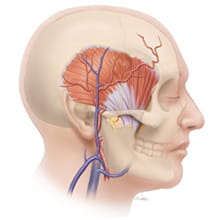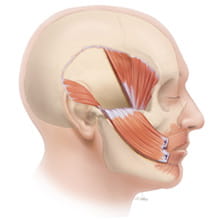Temporalis Muscle
Transfers
Local muscle transfers can be utilized to support the corner of the mouth and to re-establish some degree of active smiling. They are indicated for treating individuals whose facial paralysis is associated with damage or irreversible atrophy of the facial muscles. A segment of one of the two chewing muscles on each side of the jaw is rerouted and attached to the corner of the mouth. Clenching one's teeth together activates the redirected muscle segment, elevating the corner of the mouth into a smile.
The temporalis muscle is often chosen because its direction of pull can produce a more natural-appearing smile. This technique is often reserved for individuals whose age or general medical condition prohibits more complex microsurgical procedures. It can also be utilized to augment facial motion in individuals who have made a partial recovery.
Technique
A face lift-style incision is created in front of the ear and extended into the temple. The central segment of the temporalis muscle is released on three sides leaving its base attached. The dense leathery tissue encasing the muscle (fascia) is unfurled to extend its reach. The temporalis muscle segment is then tunneled beneath the skin of the cheek and secured to the corner of the mouth.
temporalis muscle

temporalis transfer

The void created by borrowing the muscle segment can be filled by rearranging local tissues or utilizing a number of biological or synthetic implants. Alternately, the temporalis muscle can be released from its attachment to the jaw and connected to the corner of the mouth via tendon grafts.
Recovery
The period of hospitalization with the temporalis muscle transfer typically ranges from 24 to 72 hours. Patients are required to eat a soft diet for 4 weeks after surgery and avoid pressure on the operated side of the face. Exercise and heavy lifting are also limited.
The corner of the mouth is intentionally over suspended at the time of surgery. The operated side of the face gradually relaxes and better symmetry is usually present by the third postoperative week. Six to eight weeks after surgery a physical therapy program is initiated. Practice is an essential to achieving a natural efficient smile. Over time, highly motivated individuals may even learn to smile without biting down.
Recovery
The period of hospitalization with the temporalis muscle transfer typically ranges from 24 to 72 hours. Patients are required to eat a soft diet for 4 weeks after surgery and avoid pressure on the operated side of the face. Exercise and heavy lifting are also limited.
The corner of the mouth is intentionally over suspended at the time of surgery. The operated side of the face gradually relaxes and better symmetry is usually present by the third postoperative week. Six to eight weeks after surgery a physical therapy program is initiated. Practice is an essential to achieving a natural efficient smile. Over time, highly motivated individuals may even learn to smile without biting down.
real patient case studies
Learn how facial paralysis surgery and functional restoration can help you.
